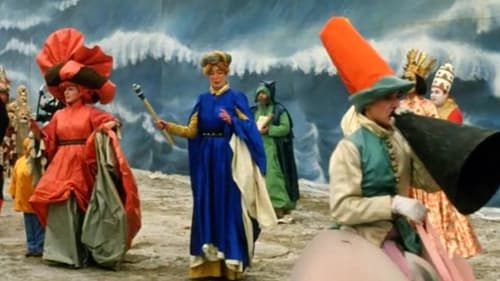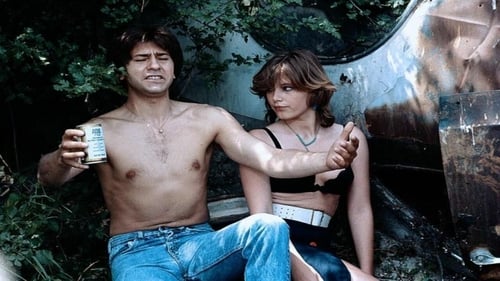
Director
Compilation consisting of 17 of Peter Weibel's earlier works.

Gustav Klimt in search of the artwork of the present. Using Klimt's paintings, "Quiet Pond" presents reasons why kitsch is art, art is kitsch, and art is art or possibly not. Who can know and who can judge?

Himself
After the fall of the Berlin wall, much changed in Yugoslavia, that is now ex-Yugoslavia; a post industrial, post modern, post national, post colonial, post structural society, that can be perhaps summarized in the concept of post socialism? The disintegration of the concept of ideology means that notions are no longer clear. Because we think that we are outside an ideological context, but perhaps we ourselves are the centre of the ideology. It is this idea that corresponds with the thoughts about post socialism in the nineties, and probably the post ideological society of late capitalism as well. The end of the ideological period then perhaps seems imminent. These thoughts are considered in this philosophical media reflection, based on documentary fragments, statements by Peter Weibel and Slavoj Zizek and the works of three artists: Mladen Stilinovic (Zagreb), "Kasimir Malevich" (pseudonym, Belgrade) and IRWIN (Ljubljana).

(segment "Lust")
Seven Women, Seven Sins (1986) represents a quintessential moment in film history. The women filmmakers invited to direct for the seven sins were amongst the world's most renown: Helke Sander (Gluttony), Bette Gordon (Greed), Maxi Cohen (Anger), Chantal Akerman (Sloth), Valie Export (Lust), Laurence Gavron (Envy), and Ulrike Ottinger (Pride). Each filmmaker had the liberty of choosing a sin to interpret as they wished. The final film reflected this diversity, including traditional narrative fiction, experimental video, a musical, a radical documentary, and was delivered in multiple formats from 16, super 16, video and 35mm.

Herr Maehrsch
Wanda is a dominatrix who runs a gallery in a building on the Hamburg waterfront, where audiences pay for the privilege of watching her humiliate her slaves. She is a business woman who smashes sexual stereotypes and social taboos with icy self-possession and an enigmatic smile. As artist she specializes in the staging of elaborate BDSM fantasies and her affairs transgress the usual boundaries of personal and professional life. Along the way she leaves her German lesbian lover, a shoe fetishist, for an American "trainee," and does more than step on the toes of the male performer who has broken the rules of the master-slave relationship by falling in love with her.

Writer
One day, Nina confesses to her boyfriend Mick, that she never has had an orgasm. Comedy about the problems of relationship and sexuality in a parody of the sex enlightenment and soft sex genre.

Writer
Menschenfrauen is a film about relationships and the psychological oppression of women in society. Franz, a journalist, maintains relationships with four women. His three mistresses are introduced with television dreams of intense emotional violence (in the first dream, a mother shouts at her daughter, explaining that as a girl, she does not deserve a room of her own), and the fourth is his wife. He is desperate to have each to himself. Franz never offers a substantial sign of love, but is willing to say anything and make any promise for affection. His dependence on women for fulfilment is explained through arguments with his wife. He claims "I am my own sound. The women produce voices within me." An understandable and sometimes sympathetic antagonist is one of the films greatest strengths. The emotional damage he causes becomes believable.

A guy having sex with a woman on a rooftop – just to get her coffee-machine.

Writer
Anna, an artist, is obsessed with the invasion of alien doubles bent on total destruction. Her schizophrenia is reflected in the juxtapositions of long movie camera takes with violently edited montages: private with public spaces; black & white with colour, still photographs with video, earsplitting sounds with disruptive camera angles. Anna uses her body like a map; after a devastating quarrel with her lover, she paints red stitches on herself. Watching their scenes together, we realize how seldom, if ever before, the details of sexual intimacy have been shown in film from the point of view from a woman. Export privileges rupture over unity and never settles for one-dimensional solutions

Peter
Anna, an artist, is obsessed with the invasion of alien doubles bent on total destruction. Her schizophrenia is reflected in the juxtapositions of long movie camera takes with violently edited montages: private with public spaces; black & white with colour, still photographs with video, earsplitting sounds with disruptive camera angles. Anna uses her body like a map; after a devastating quarrel with her lover, she paints red stitches on herself. Watching their scenes together, we realize how seldom, if ever before, the details of sexual intimacy have been shown in film from the point of view from a woman. Export privileges rupture over unity and never settles for one-dimensional solutions

Self
This film is a kind of anthology about Vienna, from the invention of film to the present day. The aim is to break down the usual clichéd "image of Vienna" such as that found in the traditional "Vienna Film" by juxtaposing documentary footage, newly shot material and subjective sequences created by various artists. Individual, self-contained sections of the film gain new meaning within the context of historical material. Familiar sites appear estranged when edited together with historical scenes. Other scenes appear like a persiflage or satirical. The film does not incorporate any commentary whatsoever. It is a collage of diverse materials aimed at conveying a distanced image of Vienna to the viewer

Director
1972 film documenting blood-giving and exhibition of the process

Director
Between the TV set and viewer, a function exists whereby the user switches on and off the appliance. I have reproduced this function and made it the content of the TV programme. Sandwich character of real process and reproduction process, of reflection and action. On the screen, a series of viewers is seen sitting in front of TV sets. A fault occurs in the last set shown, meaning the next viewer has to get up in order to repair the fault. This repair brings about a disruption in the next viewer’s screen. The disruption propagates itself until it reaches the real TV set, meaning the real viewer has to rise and eliminate the fault. Time delay: the real procedure is the conclusion of the reproduced procedure. (Peter Weibel)

Director
As an aquarium, the TV set signifies the identity of a real and reproduced event. Its images transform the TV set into an aquarium, a still-life, an object of meditation. But the water gradually runs out of the TV cabinet. The gurgling noise grows louder, the movements of the fish become more hectic, finally they are wriggling for their lives on the waterless floor of the cabinet. A warning sinusoidal tone begins to sound – censorship has saved the fish from their doom. I would have filmed the fish until they stopped flapping about, in order to produce the impression of a real death in a real TV set in a real apartment. This deliberate illusion would have shocked the audience, confronted them with real death as opposed to the pictures of death shown on the news, which now seem nothing more than illusion. (Peter Weibel)

Director
Weibel stages a documentation of the public as an exhibit themselves

‘Kunst & Revolution is a documentation on the famous action known as the “filthy uni mess”, which led to a jury court trial. I only had a few metres of film with me and they were quickly spent, but still the film gives one a rough impression of the events. As a whole mythology quickly arose around the event, I altered the material to counteract this effect (through repetition, and adding other material, for instance from a film about keeping dogs, and my own leftover footage from the Muehl action number 54 ‘Im Freudenauer Wasser’).’ In film 16 of his anthology Ernst Schmidt Jr. documented the actions of Günter Brus, Otto Muehl, Peter Weibel and Oswald Wiener.

In Hernals documentary and pseudo-documentary procedures were filmed simultaneously by two cameras from different viewpoints. The material was then divided into phases of movement. In the montage each phase was doubled. The techniques used in this process vary. Also the sound was doubled, again using different techniques. Two realities, differently perceived according to the conditions of this film, were edited into one synthetic reality, where everything is repeated. This doubling up destroys the postulate: identity of copy and image.

Director
Short film depicting a typewriter and text falling over

Director
Short film depicting a man and woman smoking

Director
Communication is the medium












